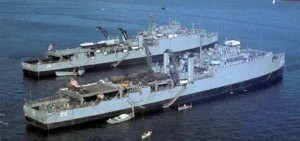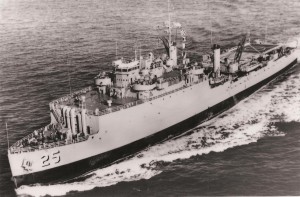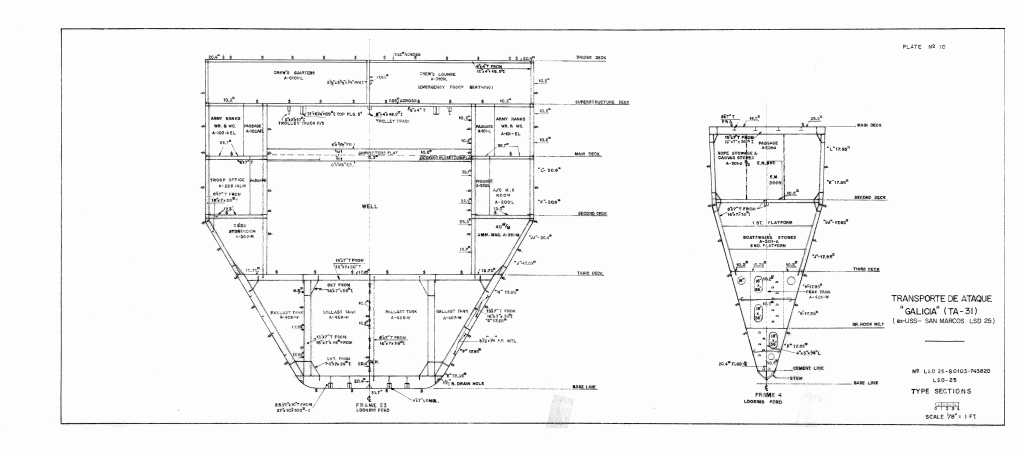Landing Ship Dock USS San Marcos
Plans for an Unusual Warship
A great subject for a ship model builder
Launched too late for World War II action, Casa Grande -class Landing Ship Dock USS San Marcos had long history nevertheless. After a 26-year career in the U.S. Navy, she went on to end her career as Spanish Navy ship Galica, where she served until 1988.
USS San Marcos (LSD-25) was a Casa Grande-class Landing Ship – Dock of the United States Navy, named for the Castillo de San Marcos, the oldest masonry fort still standing in the United States.
Her keel was laid down on September 1,1944 at the Philadelphia Navy Yard; she was launched on January 10, 1945; and commissioned on April 15 1945, Commander L. E. Ellis in command.
San Marcos completed shakedown in early May and taking on a cargo of landing boats sailed for Pearl Harbor via the Panama Canal on May 19. She arrived on June 24, unloaded and then loaded cargo, and departed for Guam on the June 29. After taking aboard additional equipment at Guam, she anchored in Buckner Bay, Okinawa, on August 12 — three days before the cessation of hostilities. On the 15th, she shifted to Naha, then Saipan. There, she loaded equipment for use by occupation forces in the Tokyo Bay area; and, on 4 September, she arrived in Japan to offload her cargo. In early December, she was reassigned and, through the end of the year, she ferried boats from Aomori to Yokohama.

In January 1946, San Marcos was assigned to Joint Task Force 1 for Operation “Crossroads,” a series of atomic tests scheduled for Bikini atoll during the summer. She remained in JTF 1 until August 29. In September, the ship sailed from the Marshall Islands to Hawaii; and by October, had arrived at San Francisco.
She resumed cargo operations along the west coast in early November and, by the end of the month, was carrying cargo to the Aleutian Islands. She continued these cargo runs to September 1947, when she was temporarily converted to a seaplane dry-dock. On December 19 she was decommissioned and berthed in San Diego.
San Marcos was recommissioned on January 26, 1951, after the outbreak of war on the Korean peninsula. After a shakedown cruise, in March she was assigned to the Atlantic Fleet’s Amphibious Force. In May, she sailed for Little Creek, Virginia via the Panama Canal.
After her arrival at her new station, she began arctic summer resupply operations to bases in Canada and Greenland. In the fall, she moved south to the Caribbean Sea for fleet exercises. In November, she arrived in Baltimore for an overhaul which lasted into the beginning of 1952, when she resumed active duty.
In April 1952, she carried a group of Marines for her first Mediterranean Sea deployment. She operated there with the 6th Fleetinto October. She then returned to the U.S. where she resumed east coast operations.
During 1953 and 1954 San Marcos continued her duties on the East Coast. From January to May 1955, she again deployed to the Mediterranean.
After her return from the Mediterranean, she continued her typical duties, with added deployments during the summers of 1956 and 1957 to polar logistic support operations. From September 1958 to March 1959, she returned to the Mediterranean with the 6th Fleet. In May 1959, she tested recovery methods for Mercury space project. That summer, she traveled to the Great Lakes for Operation “Inland Seas,” made possible by the opening of the St. Lawrence Seaway.
Throughout the 1960s and into the 1970s, San Marcos continued to rotate between the 2d and 6th Fleets. In 1961, increased tension between the United States and Cuba and political unrest in the Dominican Republic took her to extended operations in the Greater Antilles. In September of 1961 she was modified for helicopter operations, and further overhaul from late 1962 to 1963 modernized her equipment and living spaces, and improved her operational abilities.
Her annual-excluding 1964-Mediterranean deployments brought participation in fleet, binational, and multinational (NATO) exercises. In 1964, she deployed only briefly, in September, to participate in Operation “Steel Pike,” a large-scale amphibious operation held off the coast of Spain.
In 1971 she was designated for transfer to the government of Spain. Her first Spanish crew arrived in mid-April, and familiarized themselves with her through June. On July 1 1971, San Marcos was decommissioned, transferred, and recommissioned in the Spanish Navy as Galicia (TA31).Galicia’s pennant number was later changed to L31. Galicia was stricken from the Spanish Navy list in early 1988, and scrapped in 1989.
Source: http://www.history.navy.mil
USS San Marcos Specifications:
| Displacement: | 7,930 tons (loaded), 4,032 tons (light draft) |
| Length: | 457 ft 9 in (139.52 m) overall |
| Beam: | 72 ft 2 in (22.00 m) |
| Draft: | 8 ft 2 1⁄2 in (2.502 m) fwd, 10 ft ½ in (3.061 m) aft (light); 15 feet 5 1⁄2 inches (4.712 m) fwd, 16 feet 2 inches (4.93 m) aft (loaded) |
| Propulsion: | 2 Babcock and Wilcox boilers, 2 Skinner Uniflow Reciprocating Steam Engines, 2 propeller shafts – each shaft 3,700 hp, at 240 rpm total shaft horse power 7,400, 2 11 ft 9 in diameter, 9 ft 9 in pitch propellers |
| Speed: | 17 knots (31 km/h) |
| Range: | 8,000 nautical miles at 15 knots (15,000 km at 28 km/h) |
| Boats & landing craft carried: | 3 × LCT (Mk V or VI) each w/ 5 medium tanks or 2 × LCT (Mk III or IV) each w/ 12 medium tanks or 14 × LCM (Mk III) each w/ 1 medium tank or 1,500 long tons cargo or 47 × DUKW or 41 × LVI or Any combination of landing vehicles and landing craft up to capacity |
| Capacity: | 22 officers, 218 men |
| Complement: | 17 officers, 237 men (ship); 6 officers, 30 men (landing craft) |
| Armament: | • 1 × 5 in./38 cal. DP gun; • 2 × 40 mm quad AA guns; • 2 × 40 mm twin AA guns; • 16 × 20 mm AA guns |
| Aircraft carried: | modified to accommodate helicopters on an added portable deck |











[…] too late for World War II action, Casa Grande-class Landing Ship Dock USS San Marcos had long history nevertheless. After a 26-year career in the U.S. Navy, she went on to end her […]